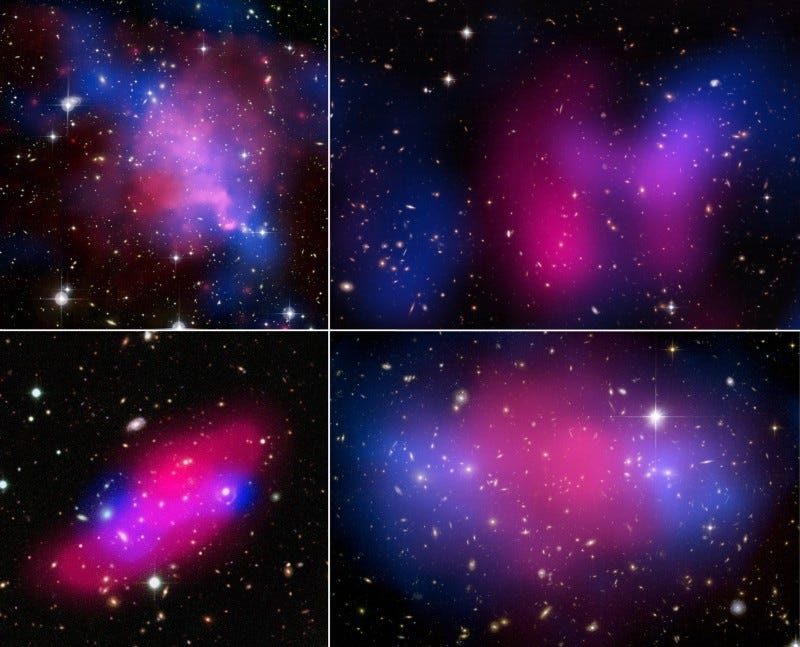Why do the tiniest galaxies have the most dark matter?

Everything else has a 5:1 dark matter-to-normal matter ratio. But get a smaller and smaller galaxy, and dark matter skyrockets!
“For the moment we might very well can them DUNNOS (for Dark Unknown Nonreflective Nondetectable Objects Somewhere).” –Bill Bryson
When we look out at the Universe, in any direction and with a variety of methods, we find the same ratios of dark matter to normal matter all over the place: 5-to-1. Whether we’re looking at the fluctuations in the cosmic microwave background, the lensing-to-X-ray ratios of colliding clusters, the way large-scale structure clumps together or the rotation properties of the largest spiral and elliptical galaxies, that same ratio — of dark matter outmassing normal matter by a 5-to-1 ratio — exists everywhere.

Everywhere, that is, until you start looking at the tiniest galaxies in the Universe. All the way down to Milky Way-sized galaxies, which represents the vast majority of galaxies we’ve discovered in the Universe, that 5-to-1 ratio remains constant. But when you go to smaller galaxies, down to dwarf galaxies in clusters or ultra-low-mass galaxies visible only in our local group (due to their tiny light output), you find that the less mass there is overall, the greater the dark matter fraction is.

In other words, the lower in mass your galaxy is, the smaller the percentage of stars and normal matter you’ll find inside, and the more dominated by dark matter it will turn out to be! This might seem paradoxical, since gravity affects both normal and dark matter equally. When you start from an overdense region, whether it’s a tiny one that grows into a miniature galaxy or a giant one that grows into a supermassive cluster, it should attract normal and dark matter equally.
But if we think about it a little bit deeper — and consider the following two pictures — it might start to make sense why dark matter comes to dominate the tiniest galaxies. It isn’t because these little ones start out with more dark matter; initially, they have that same 5-to-1 ratio that everything does. But because their gravitational pull is so weak, they have a very difficult time holding on to their matter. Unfortunately for normal matter, it interacts with both light and with other normal matter, making it incredibly easy to strip away.

When you get a large burst of star formation, you create intense, ultraviolet radiation. When the most massive stars die, they create bursts of supernovae, which ionize matter and accelerate it to near-relativistic speeds. And when you funnel matter into a black hole, it can cause jets, which eject matter into the intergalactic medium. All of these factors are at play in all galaxies, and yet these matter-ejecting effects only touch the normal matter. Because dark matter is transparent to all electromagnetic phenomena, only the normal matter gets ejected whenever you have a star-formation, stellar-death or black-hole-infalling event. On the other hand, these effects simply pass through the dark matter, and so it remains in these low-mass galaxies.

This discrepancy is compounded when you have a galaxy inside of a large cluster. The intergalactic medium there is dense and full of matter, and when these galaxies pass through, they do so at high speeds. Just as a strong wind can easily blow the loosely-held seeds off of a dandelion, the intra-cluster medium easily blows the normal matter off of the smaller galaxies in the Universe, leaving only the dark matter behind.

Take all of these effects into account, and you’ll find that the smaller and lower-mass your galaxy is, the more tenuously the normal matter is held onto in the first place, making the dark matter-to-normal matter ratio that much larger. For the smallest mini-galaxies in the Universe, ratios in the thousands-to-one are common, while if you come up to Milky Way-sized galaxies, you’re back to the 5-to-1 ratio that everything else in the Universe holds to. Everything might be born with the same ratio of dark matter to normal matter, but it’s only the big winners that hang onto their normal matter for long!
This post first appeared at Forbes. Leave your comments on our forum, check out our first book: Beyond The Galaxy, and support our Patreon campaign!





